1. Introduction
In this tutorial, we’ll learn what a priority queue is and understand how it works. Priority queues have many applications on other algorithms such as Dijkstra and scheduling algorithms. Priority queues are very important to systems that juggle multiple programs and their execution (programs are chosen to run based on their priority). They are also very important to networking systems, like the internet, because they can help prioritize important data to make sure it gets through faster.
2. Priority Queue
A priority queue is a special type of queue. Each queue’s item has an additional piece of information, namely priority. Unlike a regular queue, the values in the priority queue are removed based on priority instead of the first-in-first-out (FIFO) rule. The following example illustrates a priority queue with an ordering imposed on the values from least to the greatest:  Here,
Here, , etc. denotes the value of items while
, etc. denotes the priority of items. So the item with the highest priority in this example is
(with the priority of 1) that is removed first. And the lowest priority item,
(with the priority of 19), will be removed at the end of the process. In this tutorial, from now on, we’ll use priority as the value of items since other information can be easily attached to the queue’s elements. The main operations on a priority queue include:
- add: adds an item to the queue
- peek: returns the item in the queue with the highest priority without deleting the node
- remove: removes and returns the item in the queue with the highest priority
2.1. Characteristics of a Priority Queue
A priority queue is an extension of a queue that contains the following characteristics:
- Every element in a priority queue has a priority value associated with it
- The element with the higher priority will be moved to the top and removed first
- If two elements in a priority queue have the same priority value, they’ll be arranged using the FIFO principle
2.2. Types of Priority Queue
There are two types of priority queues:
- Min-priority queue: in a min-priority queue, a lower priority number is given as a higher priority
- Max-priority queue: in a max-priority queue, a higher priority number is given as a higher priority
 In both types, the priority queue stores a collection of elements and is always able to provide the most “extreme” element, which is the only way to extract the value from the priority queue. For the remainder of this tutorial, we’ll discuss max-priority queues. Min-priority queues are analogous.
In both types, the priority queue stores a collection of elements and is always able to provide the most “extreme” element, which is the only way to extract the value from the priority queue. For the remainder of this tutorial, we’ll discuss max-priority queues. Min-priority queues are analogous.
3. Implementation
There are different ways to implement a priority queue. The main ways include array, linked list, binary search tree (BST), and binary heap tree. The heap data structure is the most efficient way to implement a priority queue. Before diving deeper into the heap data structure, let’s briefly discuss the efficiency of each implementation approach on basic operations of queues:
Unordered Array
Sorted Array
Unordered Linked List
Sorted Linked List
BST
Heap
add
peek
remove
* The BST efficiencies assume a balanced tree, which is not guaranteed in all cases
3.1. Heap Data Structure
A binary heap is a type of binary tree (but not a binary search tree) that has the following properties:
- Every node’s value must be greater (or smaller) than all values stored in its children
- It’s a complete tree, which means it has the smallest possible height
Throughout this tutorial, we’ll be using examples of a max heap. Let’s examine the following example to understand the heap structure better:  For each node
For each node , the left child will be at
, and the right child will be at
. The parent will be at
(except for the root node at
). For a more in-depth overview of the heap data structure, we can read the article which explains Heap Sort in Java.
3.2. Priority Queue Operations
The common operations that we can perform on a priority queue include insertion, deletion, and peek. We’ll use a binary heap to maintain a max-priority queue. The item at the root of the heap has the highest priority among all elements. If we want to add a new node to a binary heap, we need to ensure that our two properties of the heap are maintained after the new node is added. At first, we insert the new item at the end of the priority queue. If it is found greater than its parent node, elements are swapped. This process continues until the new item is placed in the correct position. Let’s go through an example to understand the insertion process. If we add to the priority queue, we end up with:
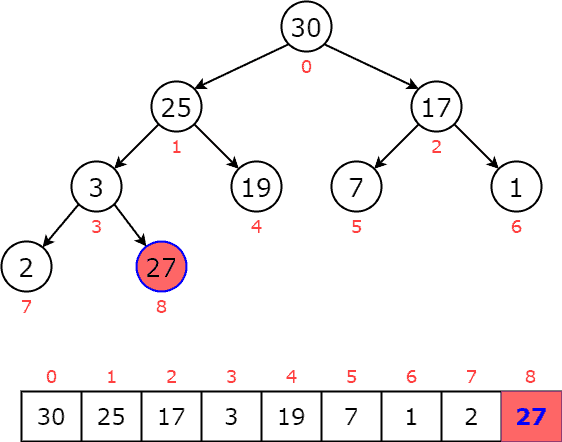 We notice that
We notice that is greater than its parent
, so we swap them:
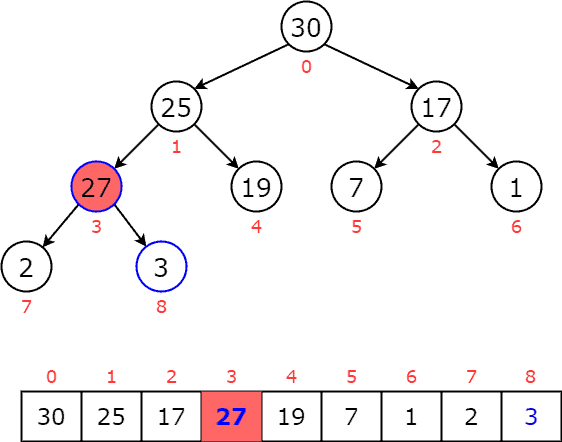 Then,
Then, is still greater than its new parent
, so we swap them:
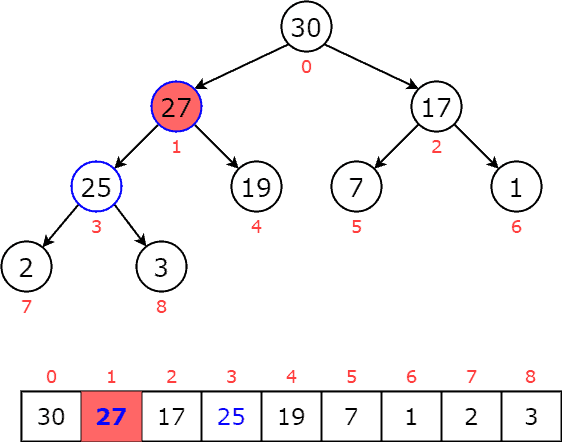 Now, we notice that
Now, we notice that is smaller than its parent, so we stop and reach our priority queue:

The following code shows the details of the insertion function:
algorithm insertIntoPriorityQueue(heap, n, val):
// INPUT
// heap = the priority queue
// n = the size of the priority queue
// val = the priority value of the new item
// OUTPUT
// Returns the priority queue after inserting the new item and re-heapifying
i <- n
heap[n] <- val
n <- n + 1
// Heapify the tree
while i > 0 and heap[(i - 1) / 2] < heap[i]:
swap(heap[(i - 1) / 2], heap[i])
i <- (i - 1) / 2
return heap
Next, we can remove the maximum element from the priority queue. As we know, the root node is the item with the highest priority in a max heap. When removing the root node, we replace it with the last item of the priority queue. Then, this item is compared with the child nodes and swap with the greater one. It keeps moving down the tree until the heap property is restored. Now, let’s apply to an example to understand how this process works. First, we replace the root node with the last item
:
 The new priority queue is now violent the max heap’s property where the root node is smaller than its children:
The new priority queue is now violent the max heap’s property where the root node is smaller than its children: 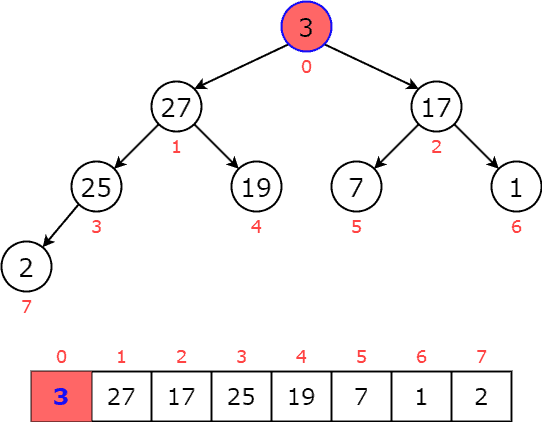 Then, we swap node
Then, we swap node with the greater child until it reaches the leaf or greater than both children:
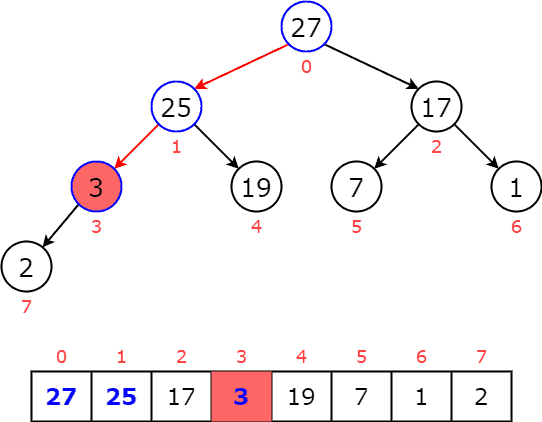 Now,
Now, is greater than its child of
, we stop and reach our priority queue:
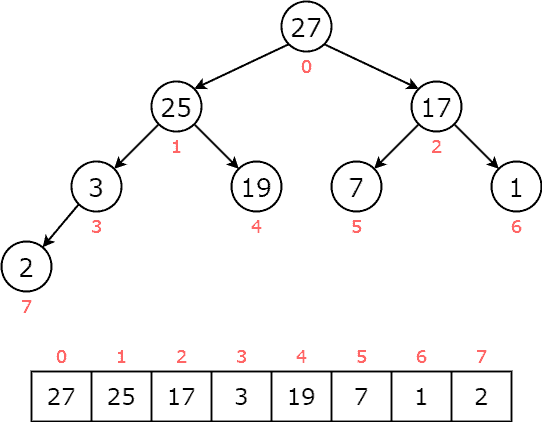
The following code shows the details of the deletion function:
algorithm removeFromPriorityQueue(heap, n):
// INPUT
// heap = the priority queue
// n = the size of the priority queue
// OUTPUT
// The item with the highest priority is removed from the queue
if n = 0:
// if the priority queue is empty
return -1
// save the max priority value to return later
max <- heap[0]
heap[0] <- heap[n - 1]
n <- n - 1
i <- 0
// Heapify the tree
while 2 * i + 1 < n:
left <- 2 * i + 1
right <- 2 * i + 2
if heap[left] > heap[right] or right >= n:
selected_child <- left
else:
selected_child <- right
if heap[i] >= heap[selected_child]:
break
swap(heap[i], heap[selected_child])
i <- selected_child
return max
If we want to peek and see the largest node in a heap quickly, that is easy. Just return a pointer to the root:
algorithm peekPriorityQueue(heap, n):
// INPUT
// heap = the priority queue
// n = the size of the priority queue
// OUTPUT
// The item with the highest priority without removing it from the queue
if n = 0:
// if the priority queue is empty
return -1
return heap[0]
3.4. Time Complexity Analysis
For insertion, we may have to heapify the entire heap data structure. So, while the insertion process only takes O(1) time, the heapify process will take . The same goes for deletion. We know where the max priority value is, but remaking the heap still takes
time. These are guaranteed worst-case efficiency since a binary heap always guarantees a complete tree. The time complexity to extract the value from a priority queue is
since we only need to peek at the root node of the heap.
4. Applications of Priority Queues
Priority queues are widely applied on other algorithms as well as in real-world systems. The main applications include:
- Algorithms: Certain foundational algorithms rely on priority queues, such as Dijkstra’s shortest path algorithm, prim’s algorithm, and heap sort algorithm, etc.
- Data compression: It is used in data compression techniques like Huffman code
- Operating Systems: Priority queues are used to select the next process to run, ensuring high-priority tasks run before low-priority ones**.** It is also applied for load balancing, and interrupt handling
- Bandwidth Management: Priority queues are utilized to prioritize the important data packet, so the network can make sure that those packets reach the destination as quickly as possible.
5. Conclusion
In this article, we discussed the data structure called a priority queue. We’ve learned the definition and characteristics of a priority queue. We’ve learned how to implement a priority queue using a heap data structure. Finally, we discussed the complexity of the priority queue’s operation and the application of priority queues.